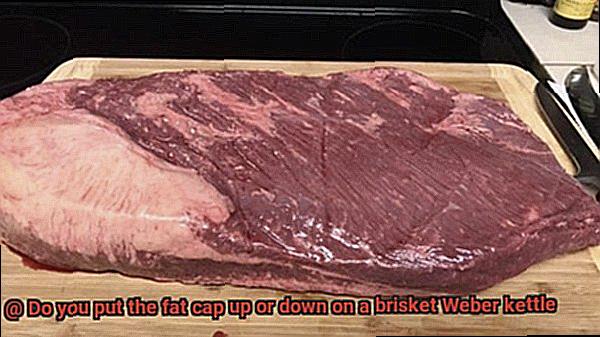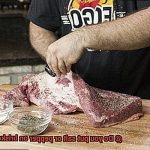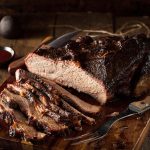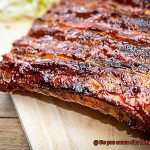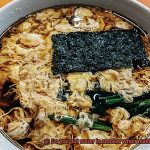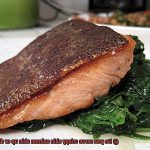Imagine this: you’re out in your backyard, the sun shining down as you fire up your trusty Weber kettle. The aroma of sizzling ribs and mouthwatering char fills the air. But there’s one thing missing—the pièce de résistance of any true barbecue feast—a juicy, tender brisket that will have everyone begging for seconds. As you prepare to tackle this meaty challenge, a question hangs in the air: Do you put the fat cap up or down on your brisket?
Don’t fret, my fellow grill enthusiasts. Join me on this quest as we unlock the secrets to cooking the perfect brisket on the Weber kettle and finally settle the age-old debate surrounding fat cap orientation.
First things first, let’s get acquainted with our star ingredient—the fat cap. This flavorful layer of fat covers one side of the brisket and plays a vital role in its tenderness, juiciness, and overall flavor. Now, let’s dive into the pros and cons of positioning that fat cap during our cooking process on our beloved Weber kettle.
The debate between fat cap up and fat cap down is as heated as a Hatfield-McCoy feud. Some swear by placing it up, claiming it allows the meat to baste in its own succulent juices. Others champion the fat cap down method, arguing it acts as an insulating shield against direct heat.
To unravel this mystery once and for all, we’ll explore both sides of the argument—diving into science-backed explanations and real-life experiences from seasoned grill masters. We’ll also examine how the unique design of our Weber kettle impacts our brisket cooking journey. Along this flavorful adventure, we’ll uncover essential tips, tricks, and techniques that will take your brisket game to new heights.
So, grab your tongs, ignite the flames, and let’s embark on this mouthwatering adventure. Get ready to indulge in smoky perfection that will leave your friends and family begging for more. Together, we’ll master the art of brisket preparation on the iconic Weber kettle and finally put an end to the great fat cap debate. Stay tuned.
Contents
What is a Brisket?
A brisket is a cut of beef that is taken from the lower chest area of the cow. Comprised of two main muscles, the flat and the point, this tough and flavorful cut requires slow cooking to become tender and juicy. The flat, also known as the “first cut,” is leaner and has less fat marbling. On the other hand, the point, or the “second cut,” boasts more fat marbling, which gives it a richer flavor and tenderness. This combination of lean meat and fat makes brisket an ideal candidate for long cooking methods such as barbecuing and smoking.
Brisket has gained popularity in recent years for its rich taste and melt-in-your-mouth texture. It is a popular choice for Texas-style barbecue, corned beef, and pastrami. When purchasing brisket, it is important to look for one that has a good amount of fat cap on top. The fat cap helps keep the meat moist during cooking and adds flavor to the final product. However, the fat cap can be left on or trimmed down depending on personal preference and cooking method.
To achieve the best results with brisket, it is recommended to choose a cut with even marbling throughout the meat. This ensures that the flavors are distributed evenly and that the meat remains tender and juicy. Whole briskets can be quite large, weighing between 10 to 20 pounds, so they are often divided into smaller cuts for cooking.
Proper handling and storage of brisket are crucial to maintain its freshness and prevent spoilage. It should be kept refrigerated and consumed within a few days or frozen for longer storage.
What is a Weber Kettle?
Enter the world of grilling, and you’ll inevitably stumble upon the legendary Weber Kettle. This extraordinary charcoal grill isn’t your average cookware; it’s a game-changer that has transformed the way we savor grilled delicacies since its inception in the 1950s. In this article, we’ll dive into the captivating world of the Weber Kettle, exploring its unique features and understanding why it has become an essential tool for grill enthusiasts worldwide.
The Design: A Marvel of Precision
The Weber Kettle commands attention with its distinctive circular shape, crowned by a majestic dome lid and adorned with an ingenious venting system. This meticulously crafted design bestows unparalleled temperature control, enabling grill masters to masterfully execute various cooking techniques. Whether you’re searing a succulent steak or patiently slow-cooking tender ribs, the Weber Kettle reigns supreme.
Durability and Heat Distribution: Built for the Long Haul
Forged from premium materials like porcelain-enameled steel, the Weber Kettle boasts exceptional durability that defies time’s relentless march. Its robust construction ensures even heat distribution, eliminating dreaded hotspots and guaranteeing flawlessly grilled fare with each culinary endeavor.
Versatility Beyond Measure
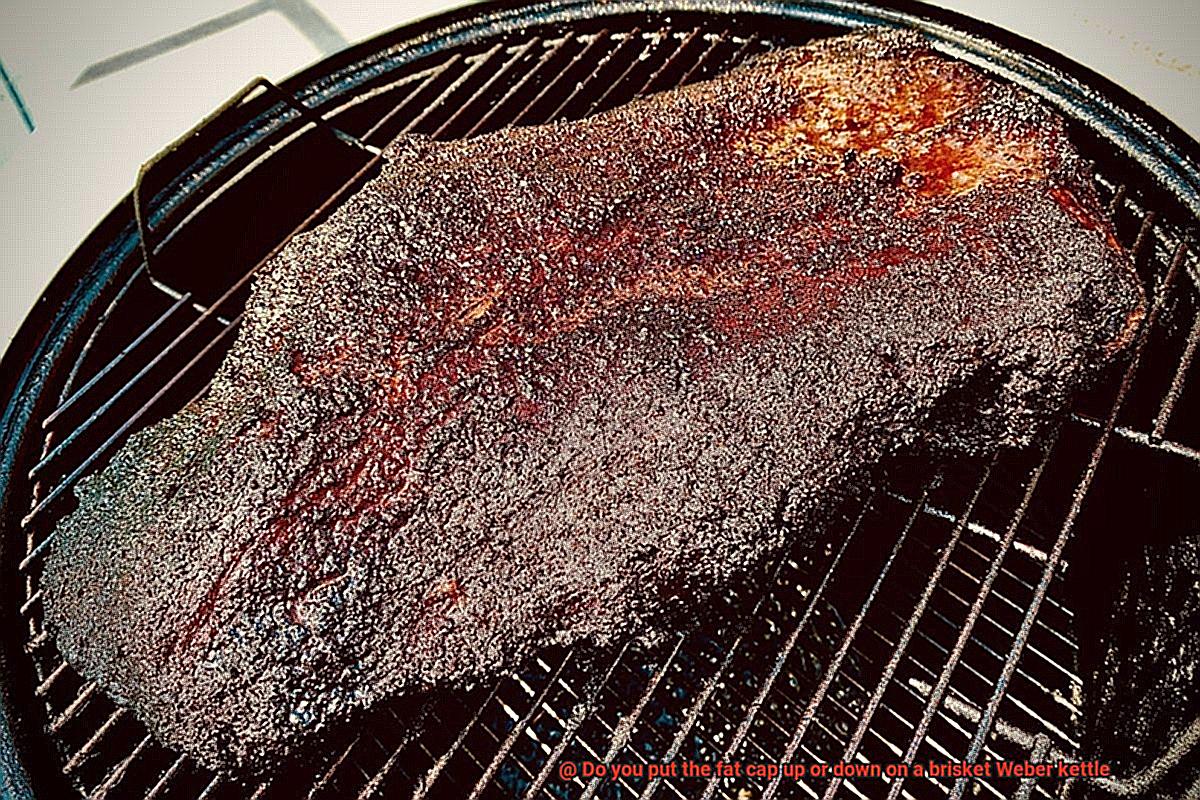
The Weber Kettle’s versatility knows no bounds. Its ingenious utilization of both direct and indirect heat renders it an unrivaled companion in culinary exploration. Directly grill mouthwatering burgers and sizzling hot dogs over fiery coals or embark on a tantalizing journey of smoked meats with the aid of indirect heat. The Weber Kettle is an unrivaled maestro of outdoor cooking, adapting effortlessly to all your gastronomic aspirations.
Effortless Cleanup: Banishing Grill-Time Drudgery
The true essence of grilling lies in relishing delectable dishes rather than grappling with messy cleanup. The Weber Kettle eases this burden with its built-in ash catcher, obliterating any traces of post-grilling chaos. Bid farewell to tedious ash management and revel in the joy of hassle-free cleanup.
Unleashing Irresistible Flavors
With unparalleled heat retention and circulation, the Weber Kettle becomes a culinary sorcerer, endowing your grilled creations with unparalleled flavor and tenderness. It conjures smoky nuances that tantalize the taste buds, transforming each bite into a moment of sheer bliss that lingers long after the last morsel has been savored.
What is the Fat Cap?
Grilling a brisket to perfection is an art form that demands skill, patience, and an understanding of the key components that contribute to its mouthwatering flavor and tenderness. Among these crucial elements is the fat cap, a luscious layer of fat that plays a vital role in creating an extraordinary brisket. In this blog post, we will delve into the concept of the fat cap, explore its significance, and provide valuable tips on how to harness its power when grilling.
The Importance of the Fat Cap:
- Flavor Explosion: The fat cap acts as a natural basting agent, releasing its flavorsome oils and juices into the meat as it renders during cooking. This infusion of rich flavors tantalizes taste buds, elevating your brisket from ordinary to extraordinary.
- Moisture Lockdown: As the fat cap slowly melts, it acts as a moisture lock, preventing excessive evaporation and ensuring that every succulent bite of your brisket is moist and juicy. Say goodbye to dry and lackluster meat.
- Protection Shield: Acting as a barrier against direct heat, the fat cap shields the meat from intense flames, preventing overcooking or charring. This protective layer allows for a controlled cooking process, resulting in uniformly cooked and tender brisket.
Using the Fat Cap Effectively:
- The Great Debate: When placing your brisket on a Weber kettle grill, you may encounter differing opinions on whether to position the fat cap up or down. Experiment with both methods to discover what works best for your taste preferences.
- Fat Cap Up: Placing the fat cap up allows the melting fat to continuously baste the meat, enhancing flavor and tenderness. It also creates a beautiful caramelized crust on the surface of the brisket, adding visual appeal to your culinary masterpiece.
- Fat Cap Down: Advocates of placing the fat cap down argue that it promotes better heat distribution and even cooking throughout the brisket. This method ensures consistent temperature across the meat, minimizing the risk of unevenly cooked sections.
Pros and Cons of Placing the Fat Cap Up
When it comes to grilling a brisket on a Weber kettle, the decision of whether to place the fat cap up or down is a topic of much debate. Let’s delve into the pros and cons of placing the fat cap up on your brisket, and explore the complexities of this culinary conundrum.
On the pro side, one of the main advantages of placing the fat cap up is its ability to provide protection from direct heat. As the fat slowly renders down, it acts as a barrier between the meat and the intense heat source. This helps prevent the brisket from drying out or getting overly charred, ensuring a juicy and tender end result.
Furthermore, placing the fat cap up has a self-basting effect. The fat contains delicious juices that infuse the meat with flavor as it slowly renders down. This natural basting process keeps the brisket moist and succulent throughout the cooking process, resulting in a truly mouthwatering experience.
Additionally, the layer of fat on top of the brisket contributes to its tenderness. As it melts into the meat, it adds moisture and richness, resulting in a melt-in-your-mouth texture that will have your guests coming back for seconds.
However, there are some drawbacks to consider when placing the fat cap up. One of these is slower rendering. Since the fat is facing up, it takes longer for it to completely render down. This can slow down the overall cooking time of your brisket, which may not be ideal if you’re pressed for time.
Another potential downside is reduced bark formation. The bark is that coveted flavorful crust that forms on the surface of the brisket during cooking. When the fat cap is facing up, it can act as a barrier, preventing proper caramelization and inhibiting the formation of a desirable crust.
Lastly, some argue that placing the fat cap up can lead to uneven heat distribution throughout the brisket. The fat acts as an insulator, causing certain areas of the meat to cook at different rates. This can result in unevenly cooked brisket with varying levels of doneness.
Pros and Cons of Placing the Fat Cap Down
Grilling a mouthwatering brisket on a Weber kettle is a culinary journey that demands finesse, patience, and a sprinkle of creativity. Among the myriad of decisions that pitmasters face, one particular question sparks intense debates – should the fat cap be placed up or down? In this comprehensive exploration, we will delve into the pros and cons of placing the fat cap down on a brisket when grilling on a Weber kettle. By examining various aspects, from protective benefits to smoke penetration, you will gain the knowledge needed to make an informed decision and elevate your grilling prowess.
The Protective Barrier:
One prominent advantage of placing the fat cap down is its role as a protective barrier. By acting as an insulator, the fat cap shields the meat from direct heat, preventing it from drying out and ensuring a tender and succulent outcome. This barrier promotes more uniform cooking temperatures, minimizing the risk of pesky hot spots.
Self-Basting Goodness:
An undeniable benefit of placing the fat cap down is the self-basting effect it creates. As the fat renders, it slowly melts, infusing the meat with flavor and imparting moisture throughout the cooking process. The result is a tantalizingly juicy brisket that leaves taste buds dancing in delight.
The Drawbacks:
While placing the fat cap down offers numerous advantages, there are potential drawbacks to consider. In some cases, the rendered fat may not fully render, resulting in a greasier end product. To counter this, consider trimming excess fat or scoring the fat cap to facilitate better rendering during cooking. Additionally, this method can hinder the development of a flavorful bark on the surface of the brisket – an aspect highly coveted by grill enthusiasts.
Smoke Penetration:
Another point of contention lies in whether placing the fat cap up allows for better smoke penetration into the meat. Advocates argue that when the fat cap faces up, it captures and holds onto more smoke, resulting in a more intensively flavored brisket.
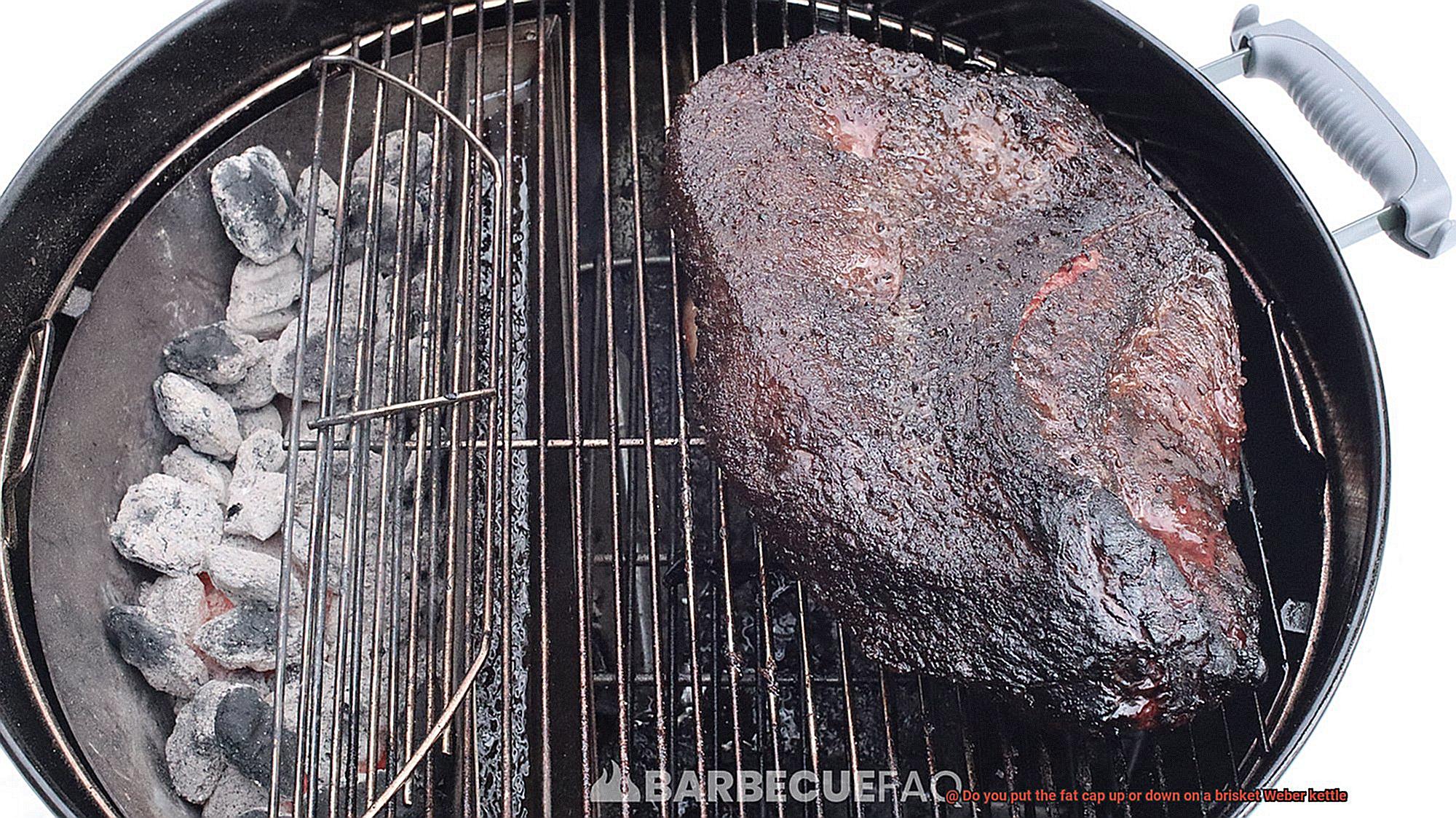
Experimentation and Personal Preference:
Ultimately, the decision of fat cap placement on a brisket Weber kettle is subjective and dependent on personal preference. It is essential to embrace experimentation, trying various methods to find what works best for you in terms of taste, tenderness, and appearance. While the fat cap serves a purpose in protecting the meat and enhancing flavor, it is advisable to trim it to a reasonable thickness rather than removing it entirely.
Trimming Excess Fat Before Cooking
Trimming excess fat before cooking is a crucial step in achieving the perfect, mouthwatering result when grilling a brisket on a Weber kettle. Let’s delve into why it’s so important.
First and foremost, we have the fat cap. This thick layer of fat covering one side of the brisket can greatly impact the cooking process if not properly trimmed. By trimming it down to about 1/4 inch or less, you allow for better heat penetration and more even cooking throughout the meat. Say goodbye to dry, unevenly cooked brisket.
Not only does trimming excess fat improve the cooking process, but it also helps prevent excessive flare-ups and reduces the risk of the fat cap becoming overly charred or burned. We all want that beautiful bark on our brisket, not an unappetizing burnt mess.
Now, let’s talk about connective tissue and silver skin. These sneaky culprits can become tough and chewy when cooked, so be sure to trim away any excess before grilling your brisket. Nobody wants to struggle with tough, chewy bites of meat.
When you’re trimming that fat, be sure to use a sharp knife and make clean, precise cuts. You don’t want to accidentally remove too much meat along with the fat. Trust me, you’ll be kicking yourself later.
Some people like to leave a thin layer of fat intact for added flavor and moisture during cooking. It’s all about personal preference and the desired end result. Play around with it and find what works best for you.
Tips for Achieving Delicious Results
Grilling a brisket on a Weber kettle can be a mouthwatering experience, but it takes some know-how to achieve those delicious results. In this guide, we’ll explore different tips and techniques that can make all the difference in flavor and tenderness. From proper seasoning to temperature monitoring, let’s dive into the world of brisket grilling.
Proper seasoning is key:
To elevate the flavor of your brisket, generously season it with a combination of salt, pepper, and any desired spices or herbs. Don’t be afraid to go bold with your seasonings. Ensure that both sides of the meat, including the fat cap, are well-seasoned. This will create an explosion of flavors in every juicy bite.
Preheat your Weber kettle:
Before placing the brisket on the grill, make sure your Weber kettle is properly preheated. This step is essential for creating a sear on the meat, sealing in its natural juices and enhancing its texture. Aim for a preheating temperature of around 225-250 degrees Fahrenheit to achieve the perfect caramelization.
Fat cap up or down?
The age-old debate continues: fat cap up or down? Placing the fat cap up allows it to render down and baste the meat as it cooks, resulting in a juicy and flavorful brisket. On the other hand, placing it down acts as a protective layer that prevents drying out and creates a deliciously crusty bark on the bottom side. Experiment with both methods to find your preferred style.
Monitor internal temperature:
Keep a close eye on the internal temperature of your brisket using a digital meat thermometer. The ideal internal temperature for perfectly cooked brisket is around 195-205 degrees Fahrenheit. Remember that each piece of meat is unique, so some trial and error may be required to find your perfect level of doneness. Don’t rely solely on cooking time – let the temperature be your guide.
Resting time:
After cooking, resist the temptation to immediately slice into your mouthwatering brisket. Instead, let it rest for at least 30 minutes. This crucial step allows the juices within the meat to redistribute, resulting in a moist and tender final product. Patience is key to achieving those melt-in-your-mouth results.
rW_7D6Ye_uE” >
Conclusion
When it comes to cooking a brisket on a Weber kettle, the question of whether to put the fat cap up or down is a hot topic. But fear not, I’m here to settle the debate once and for all.
Now, let’s talk about that fat cap. It’s like a protective shield for your precious meat, keeping it moist and flavorful during the cooking process. Some argue that placing the fat cap up allows it to melt and baste the meat as it cooks, resulting in a juicier end result.
On the other hand, there are those who swear by putting the fat cap down. They believe that this allows for better heat distribution and prevents any potential flare-ups from charring the meat.
So, what’s my take on this sizzling dilemma? Well, after years of grilling expertise, I can confidently say that it really comes down to personal preference.
If you prefer a more tender and juicy brisket with a rich smoky flavor, then placing the fat cap up might be your best bet. This way, as the fat renders down, it will continuously baste the meat and create mouthwatering results.
However, if you’re looking for a slightly leaner cut with a beautiful bark on top, then placing the fat cap down could be your winning move. This method allows for better heat circulation around the meat and promotes an even cook throughout.
Ultimately, no matter which way you choose to position that fat cap on your Weber kettle brisket, remember to monitor your cooking temperatures carefully and let patience be your secret ingredient. With some trial and error, you’ll discover your own perfect technique that will have friends and family begging for seconds.

